Smoking a beef brisket represents more than just a cooking method—it's a rite of passage for any aspiring pitmaster.
Perfecting the low and slow process of smoking transforms a notoriously tough piece of meat into a succulent feast infused with layers of complex flavors.
The journey to brisket mastery begins with understanding the intricacies from selection to serving.
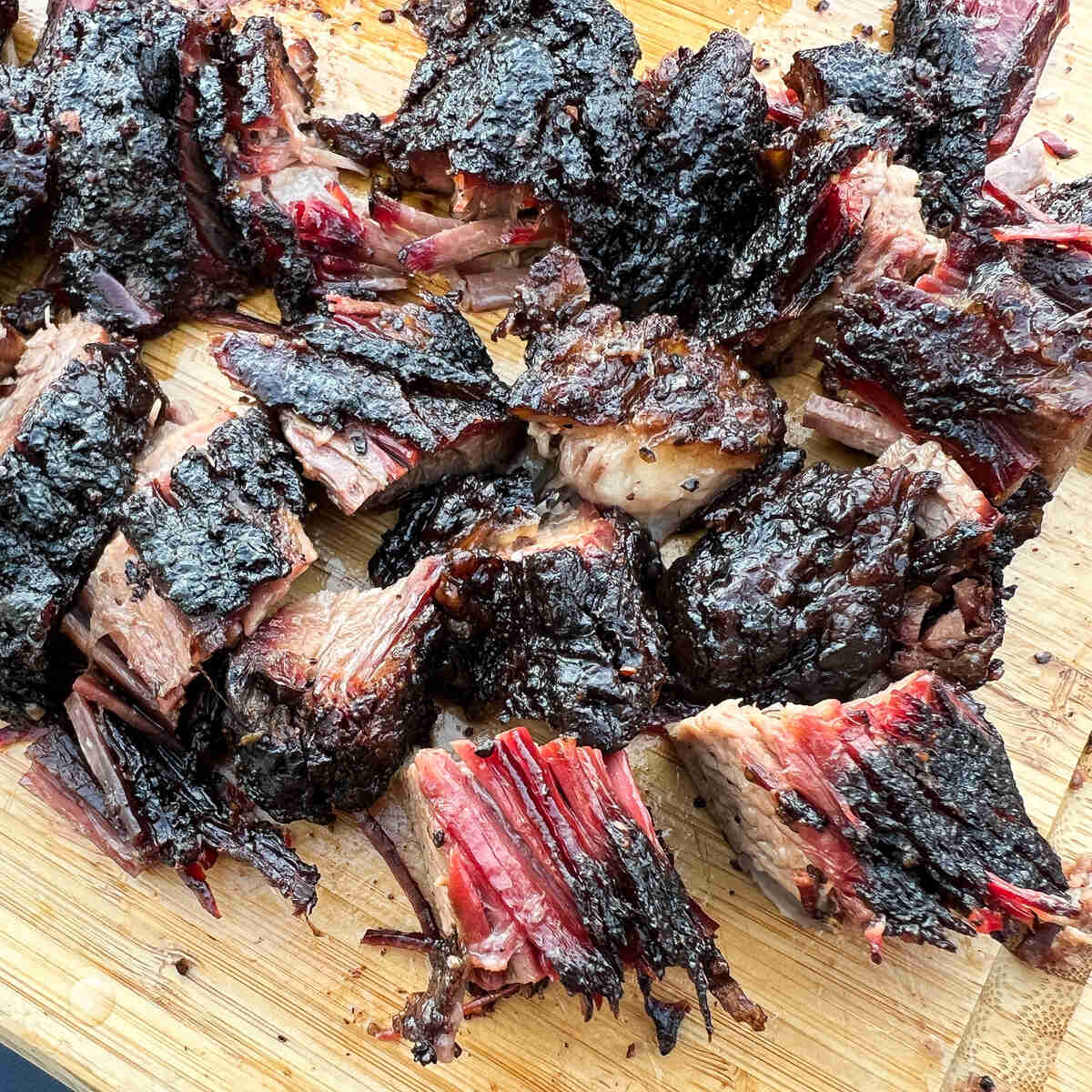
It begins with selecting the right cut—a well-marbled piece ensures richness and flavor.
Understanding the science behind meat preparation, the characteristics of different woods and fuels, and the subtleties of maintaining temperature control during the smoke can make all the difference.
No detail is too small, from the rub that crusts the surface to the rest period that follows cooking, each step is pivotal in smoking that ideal brisket.
Key Takeaways
- Selecting a high-quality brisket with good marbling is crucial for tenderness and flavor.
- Mastering the rub and smoke techniques is essential for developing depth and crust.
- Proper resting and slicing are necessary for retaining juices and achieving the perfect texture.
Jump to:
- Selecting the Perfect Brisket
- Preparation Basics
- Crafting the Perfect Brisket Rub
- Smoker Setup and Fuel
- The Smoking Process
- Monitoring Your Brisket
- Resting and Slicing
- Serving the Smoked Brisket
- Proper Storage of Leftovers
- How to Reheat and Use Leftover Brisket
- Tips and Tricks for Consistent Results
- Frequently Asked Questions
Selecting the Perfect Brisket
When we aim for the ultimate smoked beef brisket, our initial step is crucial: selecting a brisket that promises tenderness, flavor, and succulence.
Understanding Brisket Cuts
Brisket, a primal cut from the lower chest of beef, consists primarily of two parts: the point and the flat.
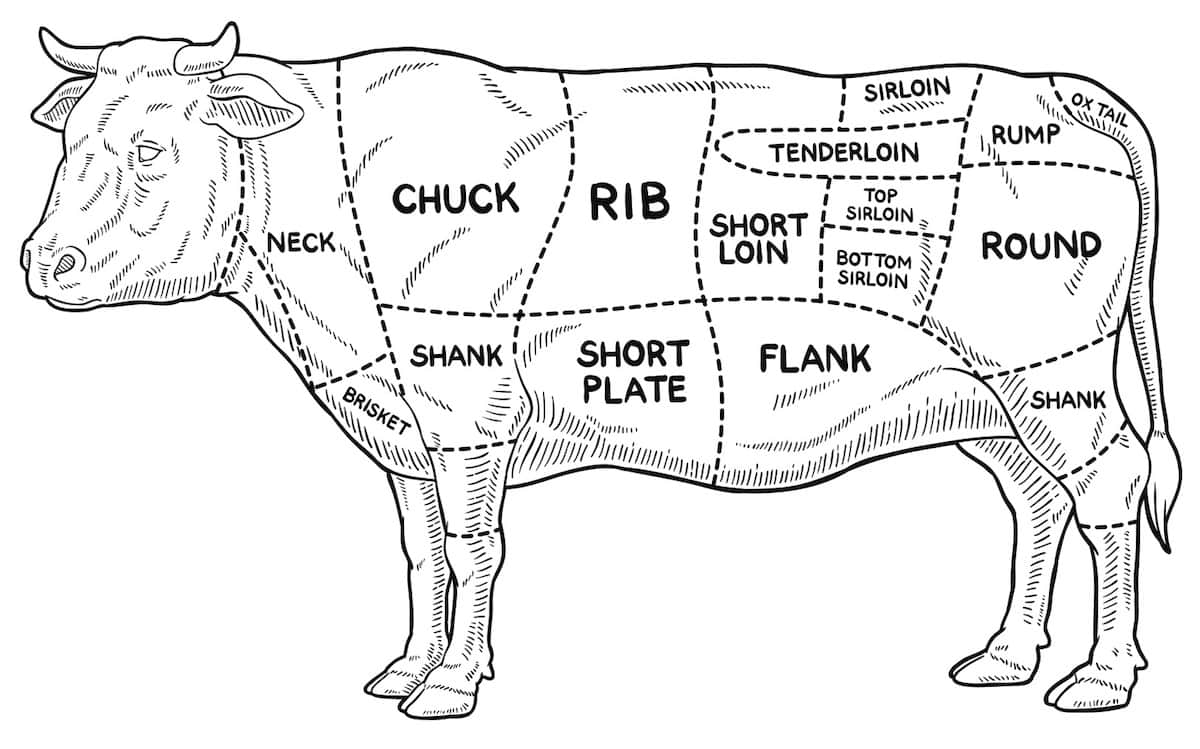
The point is thicker, fattier, and more marbled, lending itself to richer flavors and textures.
The flat is leaner with less marbling, and while it's simpler to slice, it requires careful cooking to maintain moisture.
Marbling and Quality Grades
Marbling—the little white flecks within the muscle—plays a significant role in brisket quality.
Higher marbling leads to increased flavor and juiciness. We look for a brisket with uniform marbling and a thick layer of fat to protect and baste the meat during the long smoking process.
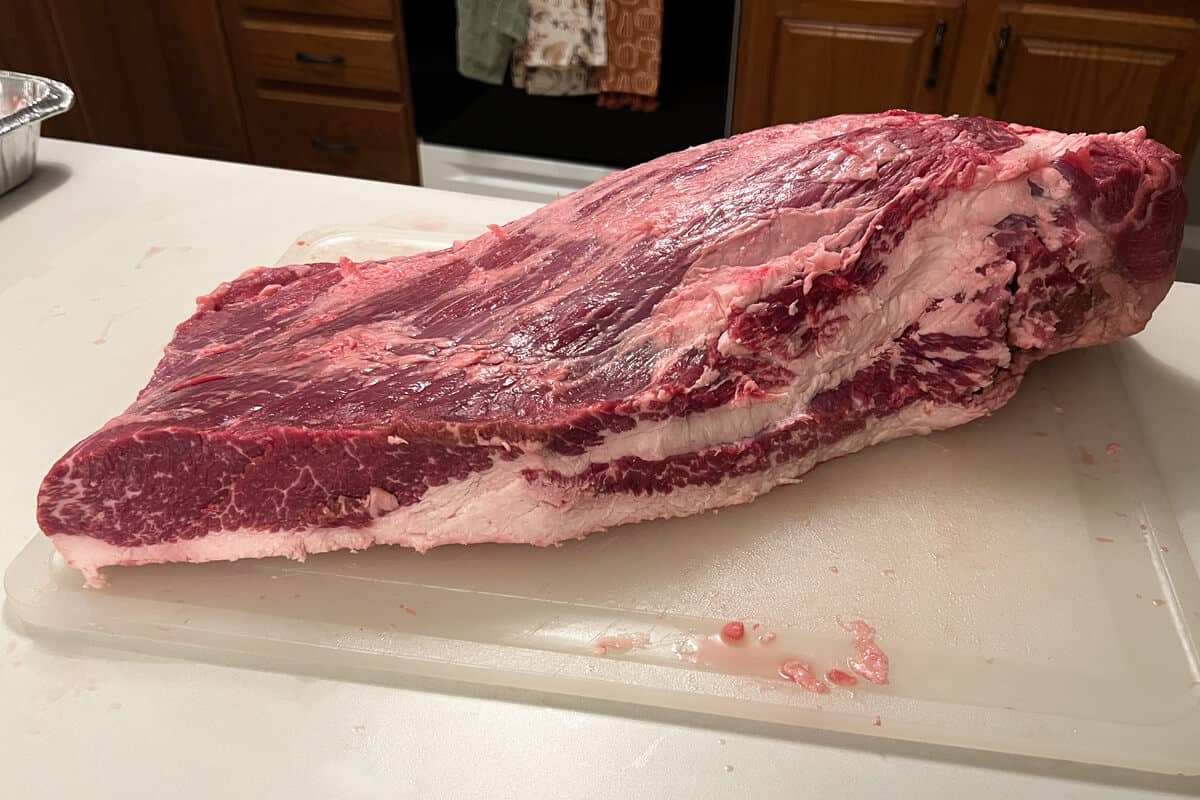
Brisket is also graded by quality.
Prime grade, with its abundance of marbling, is our top choice for a succulent smoked brisket.
Choice grade can also yield excellent results and is more widely available.
A packer brisket, which includes both point and flat, is ideal for smoking since it offers a combination of textures and flavors within the same cut.
Preparation Basics
Before we begin smoking our brisket, there are a few critical preparation steps we will undertake to ensure we get that perfect blend of flavor and texture.
Paying attention to the details of trimming, managing fat layers, and choosing the right pre-cooking treatment can make all the difference in the final result.
Trimming the Fat Cap
Trimming the fat cap optimally is a fine balance; we aim to leave about a ¼ inch layer.
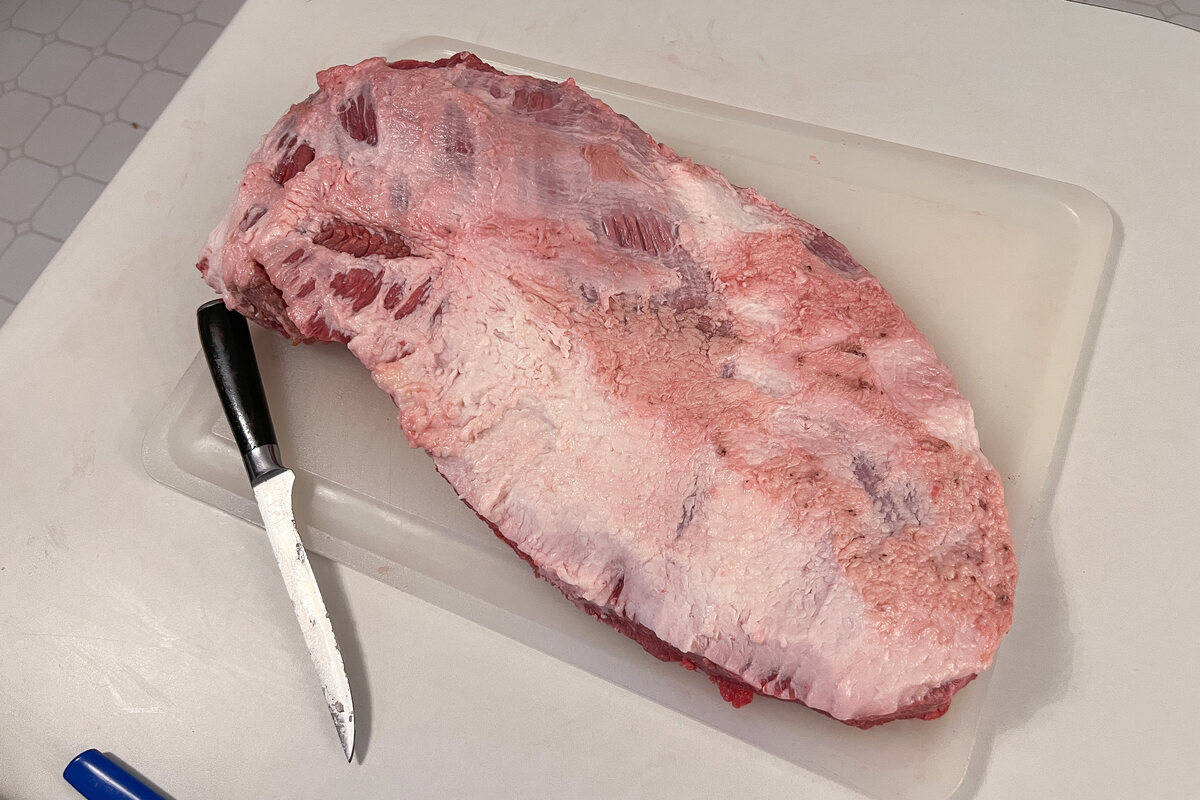
This thickness allows us to retain moisture in the meat while still getting that desired smoke penetration for flavor.
It's important to trim the fat off the brisket steadily without exposing the meat. We take care not to trim too much where the point and flat sections meet.
Removing Silver Skin
The silver skin, a membrane found on the bottom of the brisket, should be removed because it does not render down during the cooking process. This can interfere with the smoke absorption and seasonings penetration.
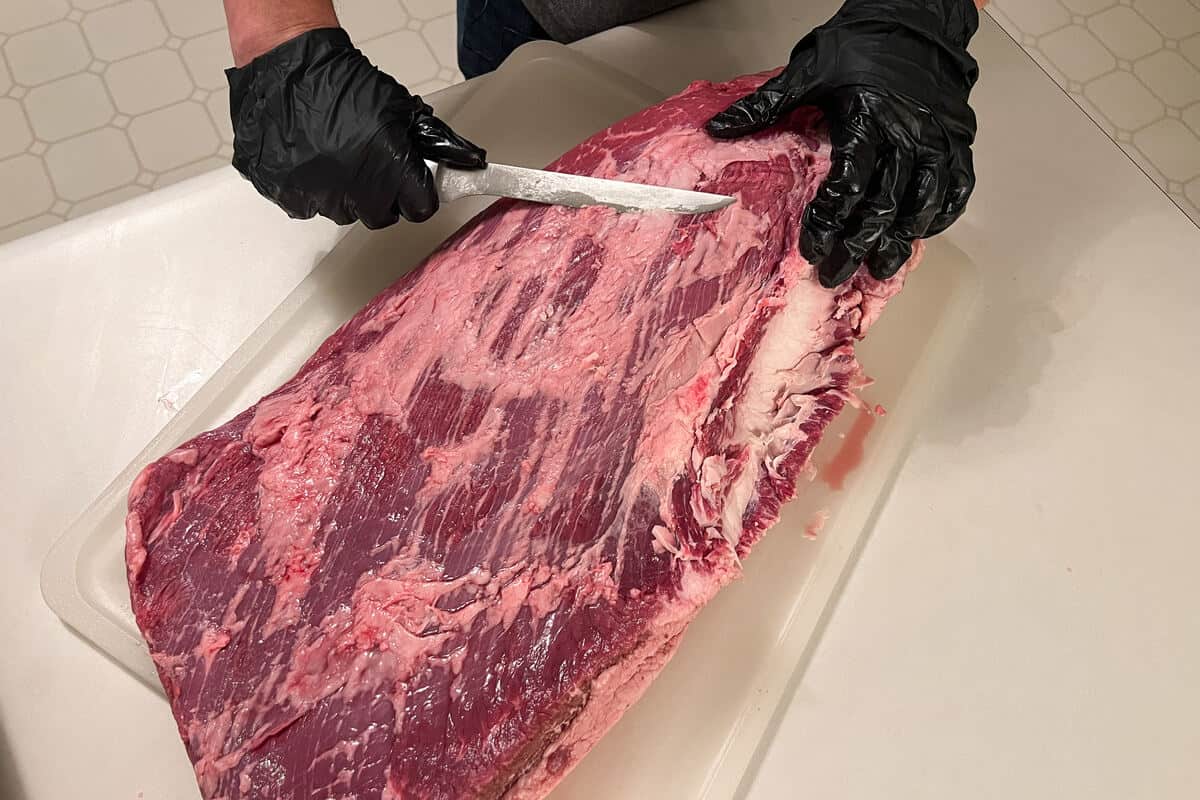
We will gently slide our knife under the membrane and peel it away, ensuring that we're only removing the silver skin and not the valuable meat underneath.
Brine or Marinade?
The question of whether to use a brine or a marinade often comes up. Dry brining by rubbing salt onto the meat helps the brisket retain moisture and seasons it deeply. This method is straightforward and enhances the meat's natural flavors.
Alternatively, a marinade for our brisket can introduce additional layers of flavor; however, we will ensure that it's not too acidic to prevent the textures from becoming mushy.
Remember, whether we choose a brine or a marinade, we will let our brisket absorb those flavors for several hours, or even overnight, before smoking.
Crafting the Perfect Brisket Rub
When we talk about smoking brisket, the rub is a critical component. It's the rub that lays down the foundation for flavor, creating that delectable bark we all love.
Let's explore how to select the right spices and strike a balance in flavors for a rub that complements the brisket beautifully.
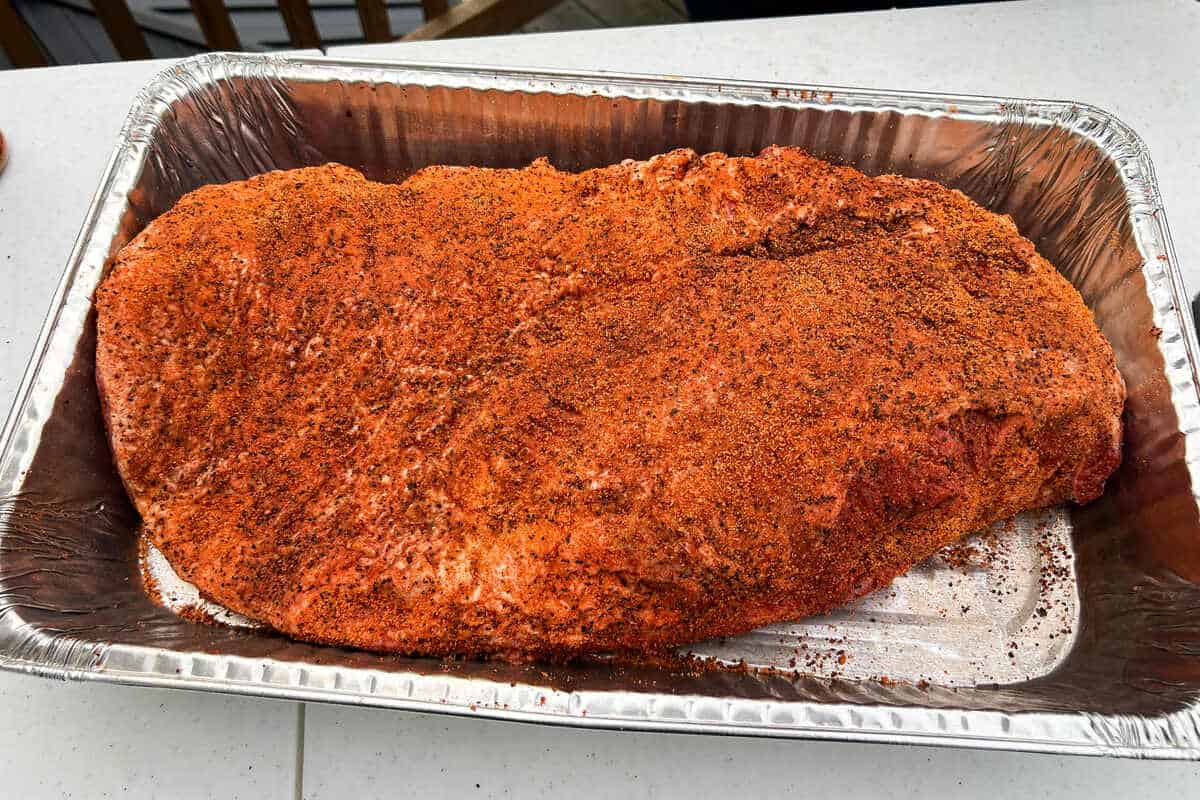
Choosing Your Spices
For our brisket rub, we start with a solid base of staples – salt, black pepper, and garlic powder.
These are non-negotiables, as they provide the essential flavors that penetrate the meat. However, the variety of spices you can add to elevate your brisket rub is extensive.
We like to incorporate a touch of cumin for its warm, earthy notes. Consider the following table for a basic rub:
| Quantity | Spice |
|---|---|
| ¼ cup | Kosher Salt |
| ¼ cup | Black Pepper |
| ¼ cup | Garlic Powder |
| 1 tbsp | Cumin |
Remember, the brisket itself is the star, and our spices are supporting actors that enhance, not overpower.
Balancing Flavors
Achieving a balanced brisket rub means hitting all the right flavor notes: saltiness, savoriness, a touch of heat, and just a hint of sweetness. It's all about proportion.
Too much salt, and we'll overwhelm the natural flavors of the meat. Not enough, and the rub won't do its job in bringing out the brisket's juiciness.
For every cup of salt, we advocate a strategy that's equal parts bold and disciplined: match it with 1 cup of black pepper for piquancy and 1 cup of garlic powder for fragrance.
Here’s a snapshot to illustrate the balance:
- 1 cup Salt
- Bold: 1 cup Black Pepper
- Aromatic: 1 cup Garlic Powder
- Optional Sweetness: 2-3 tablespoons of brown sugar (optional, but can round out the flavors)
This mix creates a harmonious rub that lets every spice sing without stepping on one another's tunes.
Now, it’s time for you to take this brisket to your smoker and let those spices work their magic.
Smoker Setup and Fuel
Before we dive into the specifics of smoker setup and fuel choice, it's crucial to understand that the success of smoking a beef brisket is highly reliant on managing a consistent cooking temperature and selecting the right type of wood to infuse the meat with the desired flavor.
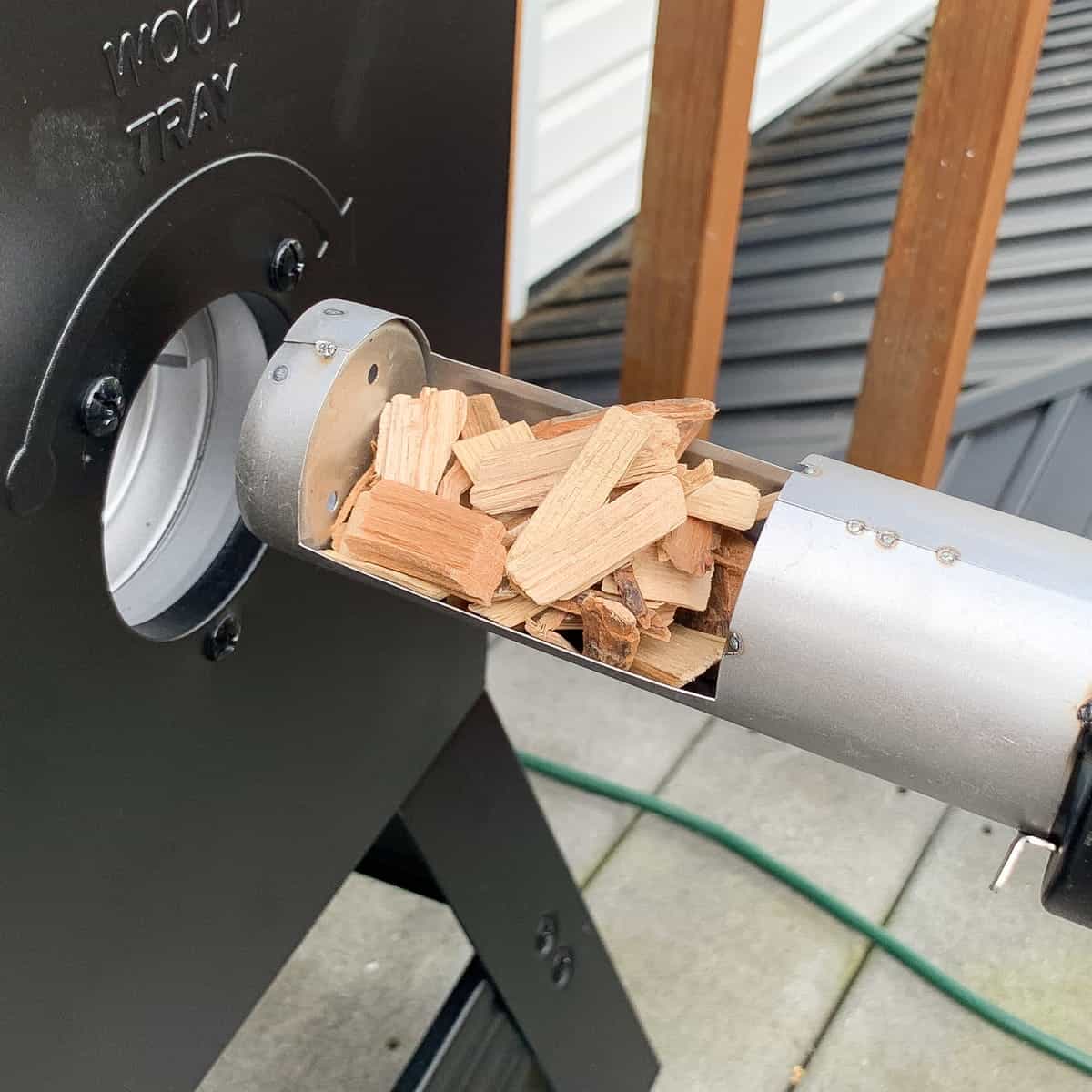
Choosing Wood and Heat Source
When selecting wood, we must consider the flavor profile it will impart.
Hardwoods like oak, hickory, or mesquite are traditional choices that provide a strong, smoky taste.
For a milder flavor, fruitwoods such as apple or cherry wood are excellent options. It's also important to match the type of smoker with the appropriate fuel.
- Pellet Grills: Utilize compressed wood pellets that come in various flavors and make it easier to maintain a consistent temperature.
- Electric Smokers: Require wood chips; they're easy to use and maintain temperature, ideal for those new to smoking.
- Charcoal Smokers: Offer a more hands-on experience and use charcoal as the primary heat source with wood chunks or chips added for flavor.
Maintaining Temperature
Maintaining an even cooking temperature is vital for smoking brisket.
We aim for a range of 225-250 degrees Fahrenheit, as this low and slow approach results in a tender and flavorful brisket. Here are some tips:
- For pellet and electric smokers, take advantage of built-in thermostats that control the temperature.
- With charcoal smokers, regulate airflow using vents: Open vents to increase the temperature and close them slightly to decrease it.
Remember, maintain a steady supply of your chosen wood or fuel to keep the temperature consistent throughout the smoking process.
The Smoking Process
When smoking a brisket, mastering the balance of smoke and heat is crucial, as is navigating the notorious stall that occurs during cooking.
Managing Smoke and Heat Flow
Proper smoke flow is essential for imparting that sought-after flavor into our brisket. We aim for a thin blue smoke indicating an efficient burn—thick white smoke can lead to a bitter taste.
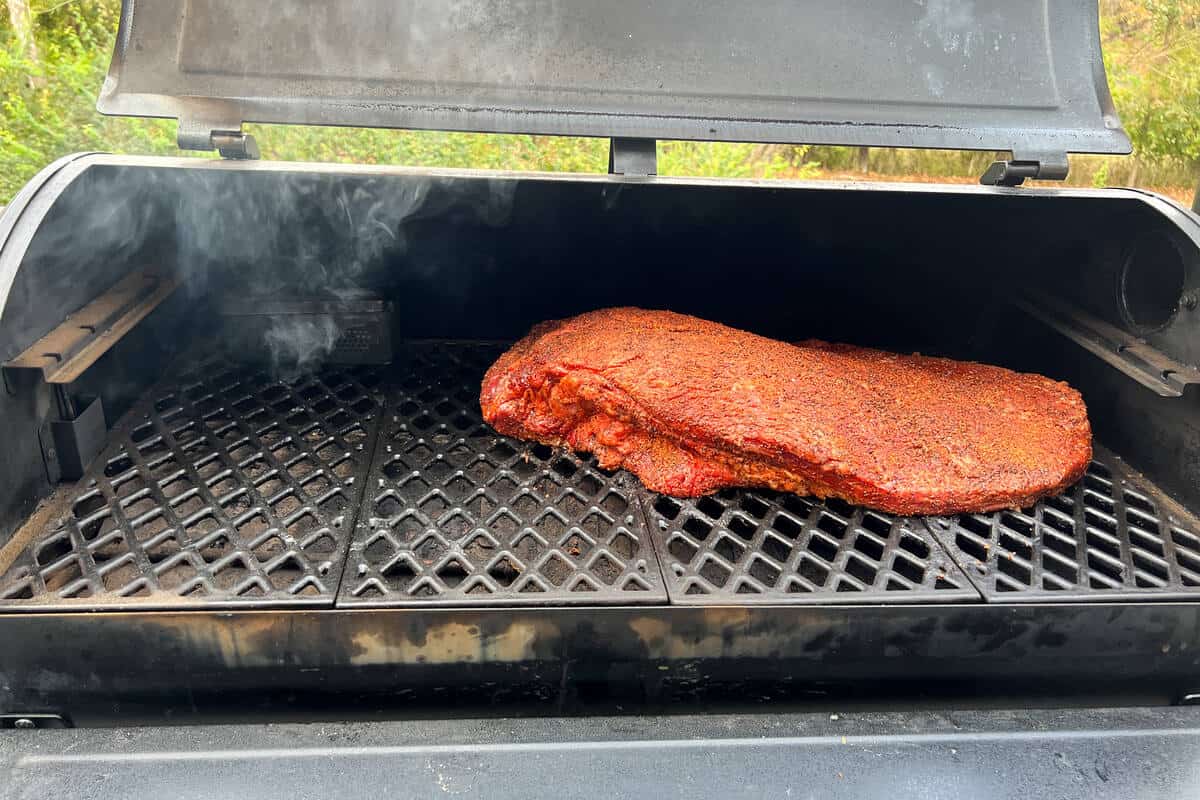
Using quality wood chips or pellets ensures a consistent and clean smoke. We meticulously maintain our smoker temperature between 225-250℉ for optimal cooking conditions.
| Smoking Medium | Temperature Range | Smoke Quality |
|---|---|---|
| Wood Chips | 225-250℉ | Thin Blue Smoke |
| Pellets | 225-250℉ | Even, Clean Burn |
The Stall and How to Overcome It
The dreaded stall occurs when our brisket's internal temperature plateaus as moisture evaporates from the meat's surface, cooling it down—a bit like sweating cools us.
To counter this natural phenomenon, we employ the Texas Crutch method; wrapping the brisket in foil or butcher paper once it reaches around 150-160℉.
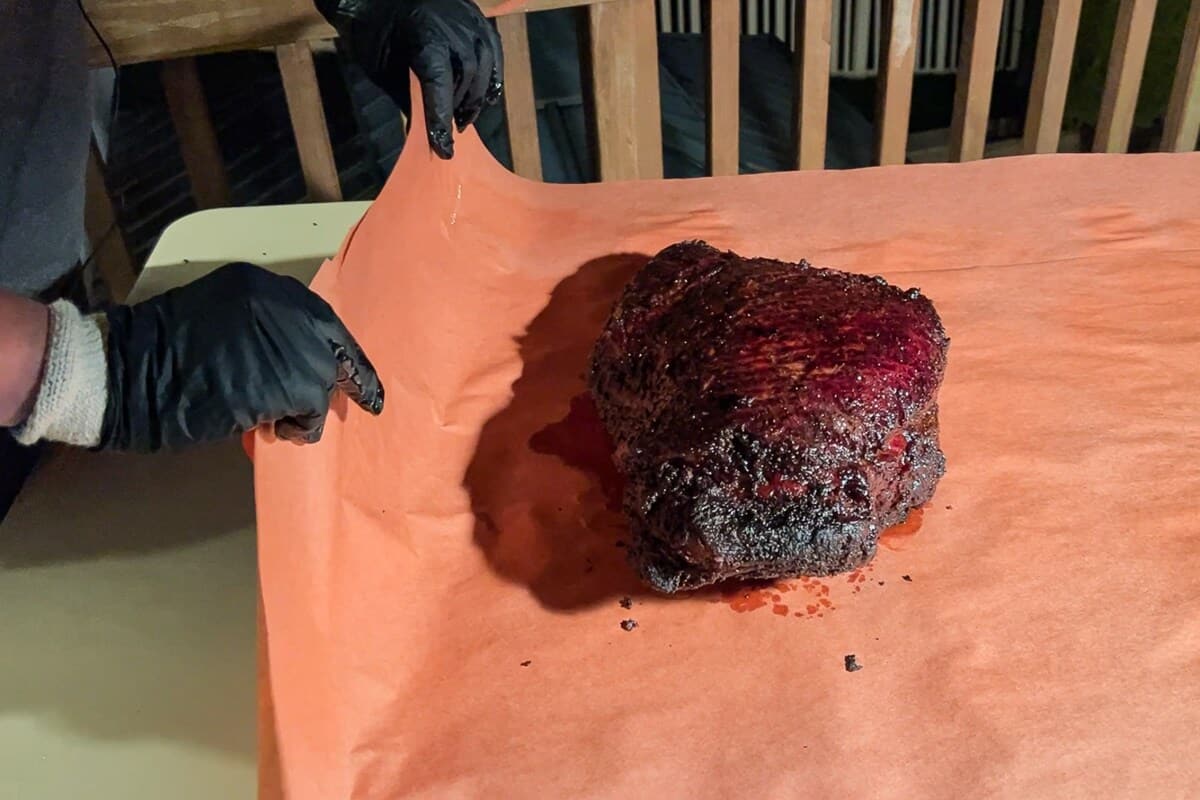
This not only helps push through the stall but also preserves the precious moisture within the brisket.
- Before Stall: Smoke brisket until it reaches 150-160℉
- During Stall:
- Option 1: Wrap in foil for a softer bark and more moisture
- Option 2: Wrap in butcher paper to allow the brisket to breathe and develop a firmer bark
By understanding and controlling these elements in the smoking process, we ensure that our smoked brisket is both succulent and flavorful.
Monitoring Your Brisket
Proper monitoring is critical to achieving a perfectly smoked brisket.
We use precision to ensure the meat reaches the ideal internal temperature while paying close attention to its transformation during resting for optimal tenderness and moisture.
Using a Meat Thermometer
For precision, we always use a meat thermometer to keep tabs on the brisket's internal temp.
A digital meat thermometer is our tool of choice, as it provides accurate and instant readings.
We insert the thermometer into the thickest part of the brisket, avoiding fat or bone, and look for an internal temp of around 195°F to 205°F.
It's vital to monitor the temperature closely as it approaches the target range to avoid overcooking.
Assessing Doneness
Judging the brisket's readiness goes beyond just temperature readings; it involves a bit of intuition and experience.
We assess doneness by checking if the meat is tender to the touch and if the thermometer probe slides in with little resistance. After reaching the desired internal temp, we focus on wrapping and resting.
Wrapping the brisket and letting it rest is crucial as it allows the juices to redistribute, ensuring the meat remains moist.
We recommend a rest time of at least four hours in an avone set to WARM (about 170°F), but eight hours is often better for optimal results.
Resting and Slicing
After meticulously smoking our beef brisket, we arrive at crucial steps that can greatly affect the meat's texture and tenderness: resting it properly and slicing it carefully.
The Importance of Resting Time
Resting is vital because it allows the juices within the brisket to redistribute. This step ensures that when we slice into the meat, these juices don't run out, leaving our brisket dry.
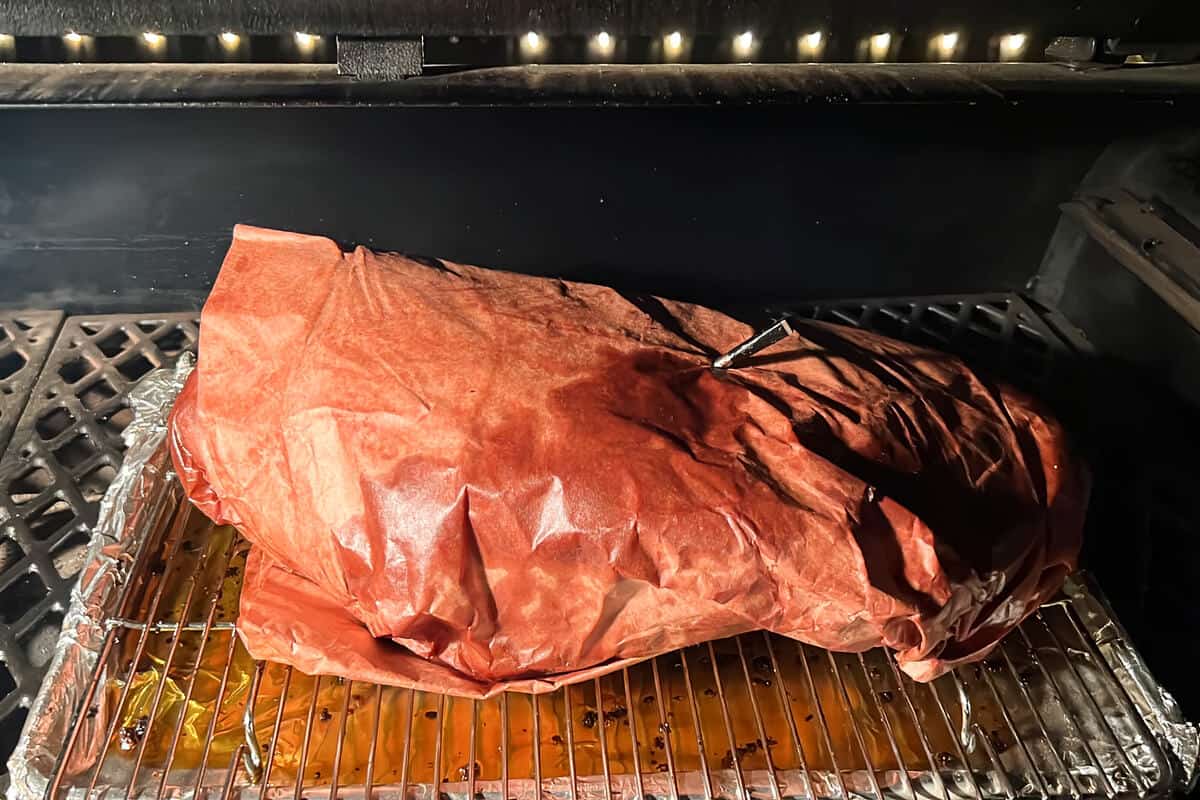
An effective resting strategy, like the faux Cambro method, can make a world of difference, allowing the brisket fibers to relax and reabsorb the juices that make the meat succulent.
Cutting Against the Grain
When it comes to slicing, precision is key. We cut our brisket against the grain to shorten the muscle fibers, enhancing the meat's tenderness.
In practice, this means identifying the direction of the muscle fibers and slicing perpendicular to them.
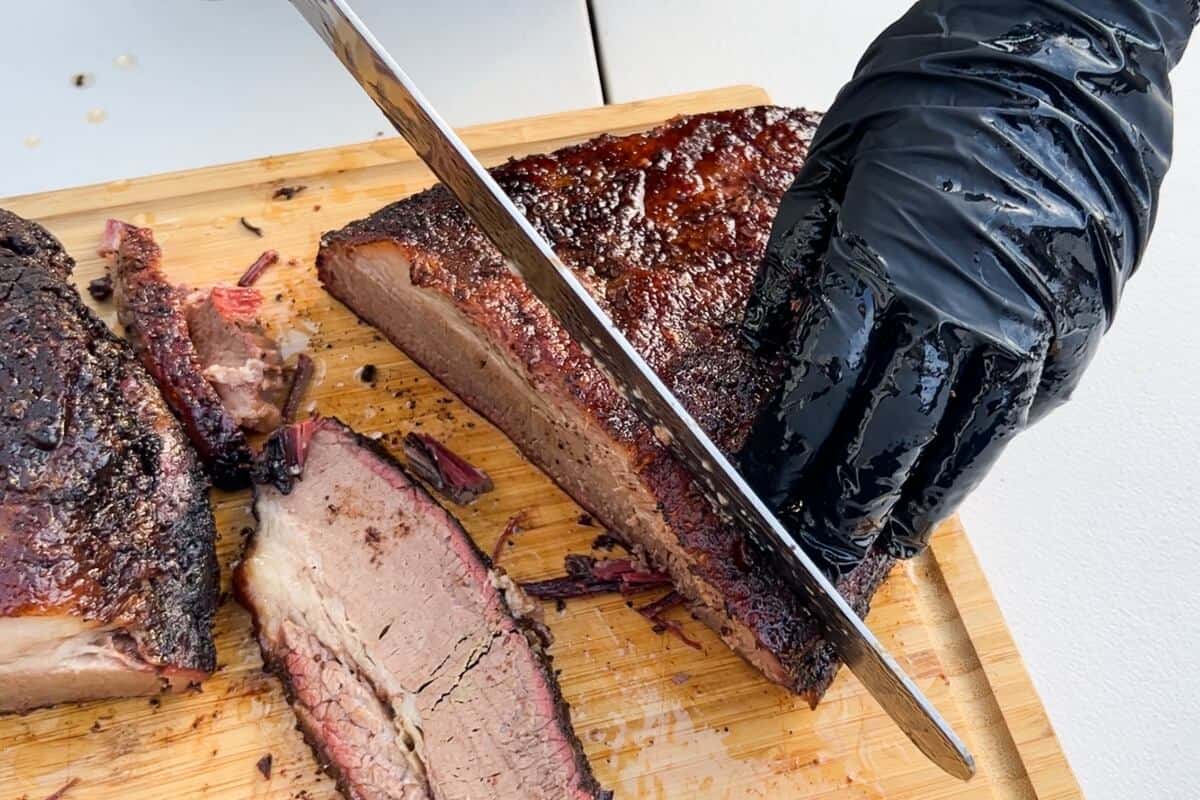
The brisket point and brisket flat usually have fibers running in different directions, necessitating careful examination before making the cuts.
Remember, the right slicing technique will complement the meat's natural tenderness acquired from the slow smoking process, resulting in slices that are both aesthetically pleasing and effortlessly enjoyable for eating.
Learn more about the proper slicing technique from Smoked BBQ Source's guide.
Serving the Smoked Brisket
After meticulously following our chosen smoked brisket recipe, the perfect brisket deserves a presentation that honors our hard work.
From the right sides to the ideal sauces, we explore how to make serving this delectable dish a memorable experience.
Recommended Sides and Sauces
Sides:
- Macaroni & Cheese: A creamy, cheesy complement that balances the smokiness of the brisket.
- Coleslaw: A tangy, fresh slaw cuts through the richness of the meat.
Sauces:
- Classic BBQ Sauce: Our brisket shines with a side of sweet and tangy BBQ sauce.
- Spicy Mustard Sauce: The brisket's bold flavor is enhanced by the sharpness of a good mustard sauce.
Presentation Techniques
Traditional Platter:
- Slice the brisket against the grain into consistent, pencil-width slices.
- Present on a wooden cutting board for rustic appeal; include a sauce boat of our homemade sauces.
Individual Plates:
- Serve a generous slice on warm plates.
- Drizzle with sauce and garnish with a sprig of rosemary for an aromatic touch.
Proper Storage of Leftovers
When we've invested time and care into smoking a beef brisket, ensuring leftovers stay delicious requires proper storage. Let's walk through the steps to keep your brisket fresh and flavorful for as long as possible.
First, we don’t want to leave the brisket sitting out for more than two hours due to food safety concerns.
Once the brisket has cooled, we need to seal it properly before placing it in the refrigerator or freezer.
Refrigerating Brisket:
- Step 1: Allow the brisket to cool, but do not leave at room temperature for longer than two hours.
- Step 2: Wrap the brisket tightly in aluminum foil or butcher paper.
- Step 3: Place the wrapped brisket in an airtight container or resealable plastic bag.
- Step 4: Store in the coldest part of the refrigerator.
- Expected shelf life: 3-4 days for best quality.
Leftover brisket can remain flavorful and enjoyable for several days if stored correctly in the refrigerator. The key is airtight packaging to prevent drying out and to maintain freshness.
Freezing Brisket:
- Step 1: Follow steps 1 and 2 above.
- Step 2: Wrap again with a layer of plastic wrap or use a vacuum-sealed bag to minimize air exposure.
- Step 3: Label the package with the date, then freeze.
- Expected shelf life: Maintains best quality for 2-3 months.
Freezing is the best option for extending the shelf life of your leftover brisket. Just remember that the key to freezing is minimizing air exposure to prevent freezer burn.
By following these methods, we keep our smoked brisket fresh, safe to eat, and ready for next time we crave its succulent flavors.
How to Reheat and Use Leftover Brisket
When we have leftover brisket, it's important to reheat it in a way that maintains its juiciness and flavor. Here are our top methods for reheating brisket:
Oven Method
- Preheat the oven to 325°F (163°C).
- Wrap the brisket in aluminum foil. If you have it, add a spoonful of beef broth to the foil to enhance moisture.
- Heat in the oven for 30-45 minutes, checking for an internal temperature of 165°F (74°C) — the safe temperature for reheated foods.
Sous Vide Method
- If you have a sous vide setup, you can reheat your brisket to precisely 165°F (74°C).
- Seal the brisket in a plastic bag and immerse it in a water bath at the aforementioned temperature for about 1-2 hours. Learn about sous vide reheating.
Stovetop Method
- For a quick method, use a covered skillet with a small amount of beef broth.
- Simmer on a low heat until the brisket reaches the desired temperature.
Once our brisket is reheated, we can use it in numerous dishes:
- Shred for brisket tacos or sandwiches.
- Chop and throw into stews or chili.
- Slice thinly and add to a salad or wrap.
Remember to store your leftover brisket properly in the fridge or freezer to ensure it remains safe to reheat and consume.
By following these methods, we ensure that our leftover brisket is just as delicious the second time around.
Tips and Tricks for Consistent Results
To master the art of smoking beef brisket, we focus on honed techniques and steadfast patience.
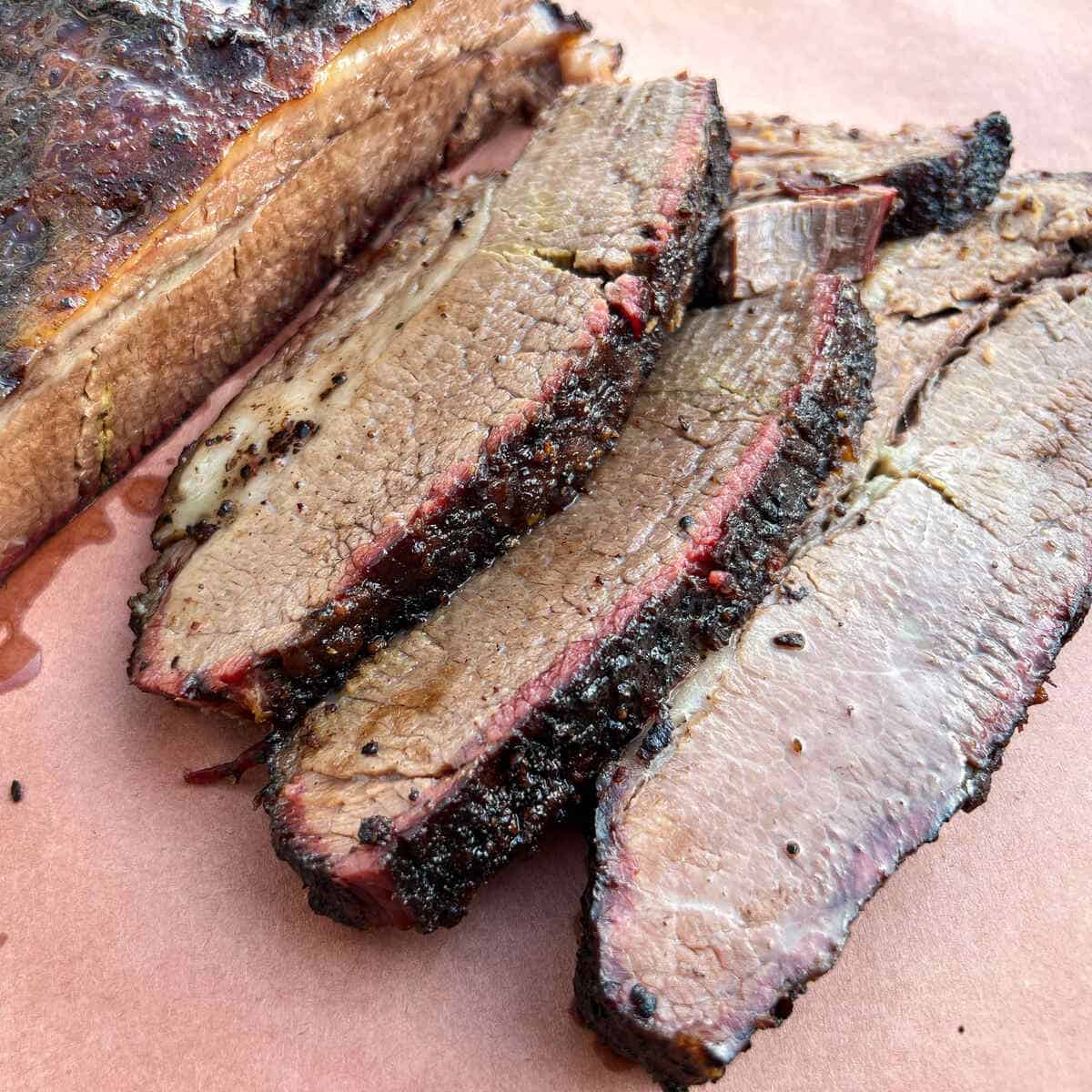
Our guide provides pitmaster-proven advice and essential troubleshooting to help you achieve perfect results every time.
Advice from Pitmasters
Proper Meat Selection: Selecting the right brisket is foundational for great results. We look for briskets with a firm texture and consistent fat marbling to ensure moisture and flavor. It's essential to start with quality meat; this often means choosing a brisket that has a good layer of fat on the top to keep the meat moist while it smokes. Learn how to select the perfect brisket.
Temperature Control: We maintain a temperature range between 225°F and 250°F. This low and slow approach allows the tough fibers in the brisket to break down, resulting in tender meat. Reliable temperature control is crucial, whether using a pellet grill, electric, or gas smoker. Tips for maintaining ideal smoking temperature.
Patience is Key: Brisket smoking is not a race; it's a low-and-slow journey. Roughly, it takes about 30-60 minutes per pound, so for a brisket to fully smoke to tenderness, it can often take upwards of 10 hours. We plan and manage our time accordingly to ensure we’re not rushing the process. Understand the importance of going slow and low.
Mastering Techniques: Techniques vary from smoking a Texas-style brisket to experimenting with injecting brisket for extra flavor and juiciness. We regularly practice and refine our smoking techniques, ensuring each brisket comes out better than the last.
Troubleshooting Common Issues
-
Uneven cooking: If part of the brisket is cooking faster than another, we adjust its position in relation to the heat source. Consistent rotation might be necessary.
-
Stalling Temperatures: Known as "the stall," brisket temperatures can plateau. We don't panic. Instead, we might employ a Texas Crutch—wrapping the brisket in foil or butcher paper to overcome this phase.
-
Dryness: If brisket starts to dry out, we ensure it's not overexposed to heat and may introduce more moisture. This could be through a drip pan with water, spraying the brisket with apple juice, or wrapping it.
Smoking brisket is a craft that blends art with science.
Through persistent practice and heed to the wisdom from experienced pitmasters, we learn to yield the juicy, flavorful brisket that is the signature of any barbecue aficionado.
Frequently Asked Questions
In this section, we'll address some of the most common questions and concerns when it comes to smoking beef brisket, ensuring that you have all the information required for that perfect smoke.
What are the key steps for smoking a tender beef brisket?
The process involves selecting a high-quality cut, proper trimming, seasoning with a robust rub, and smoking at a low temperature for several hours. Ensuring consistent smoke and managing the fire to maintain even temperatures is crucial for a tender result.
Which cut of brisket is best suited for smoking to achieve optimal flavor and texture?
The best cut for smoking is the point end, which has more intramuscular fat, or marbling, that renders down during the long smoking process, imparting flavor and maintaining juiciness.
What internal temperature should beef brisket reach for perfect doneness when smoking?
The ideal internal temperature for a smoked brisket is between 195°F and 205°F. At this range, the connective tissues have properly broken down, making the meat tender and full of flavor.
Could you provide a detailed temperature chart for smoking brisket?
Certainly. Start by smoking the brisket at 225°F until the internal temperature reaches about 160-170°F. Then, wrap the brisket and continue to cook until it hits an internal temperature of 195°F to 205°F for the perfect doneness.

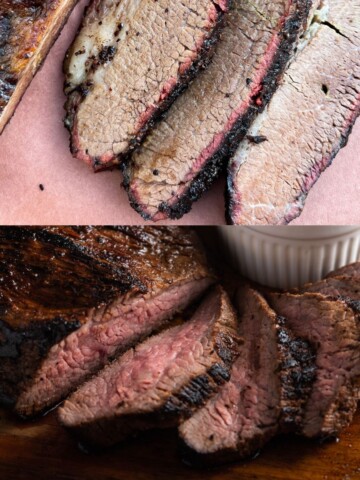
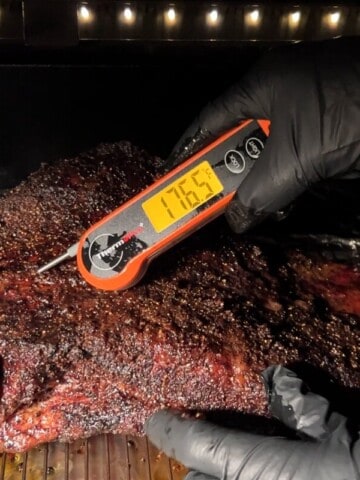
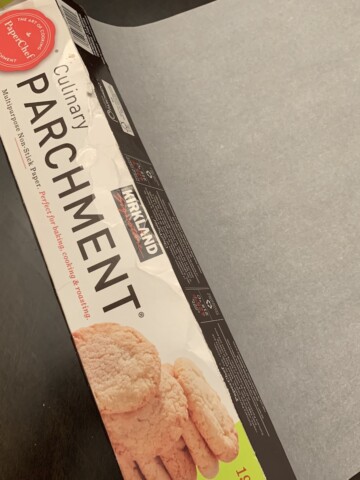
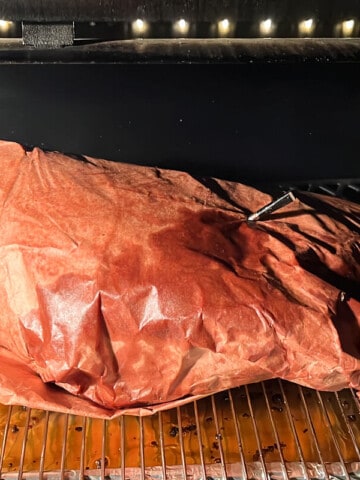
Leave a Reply